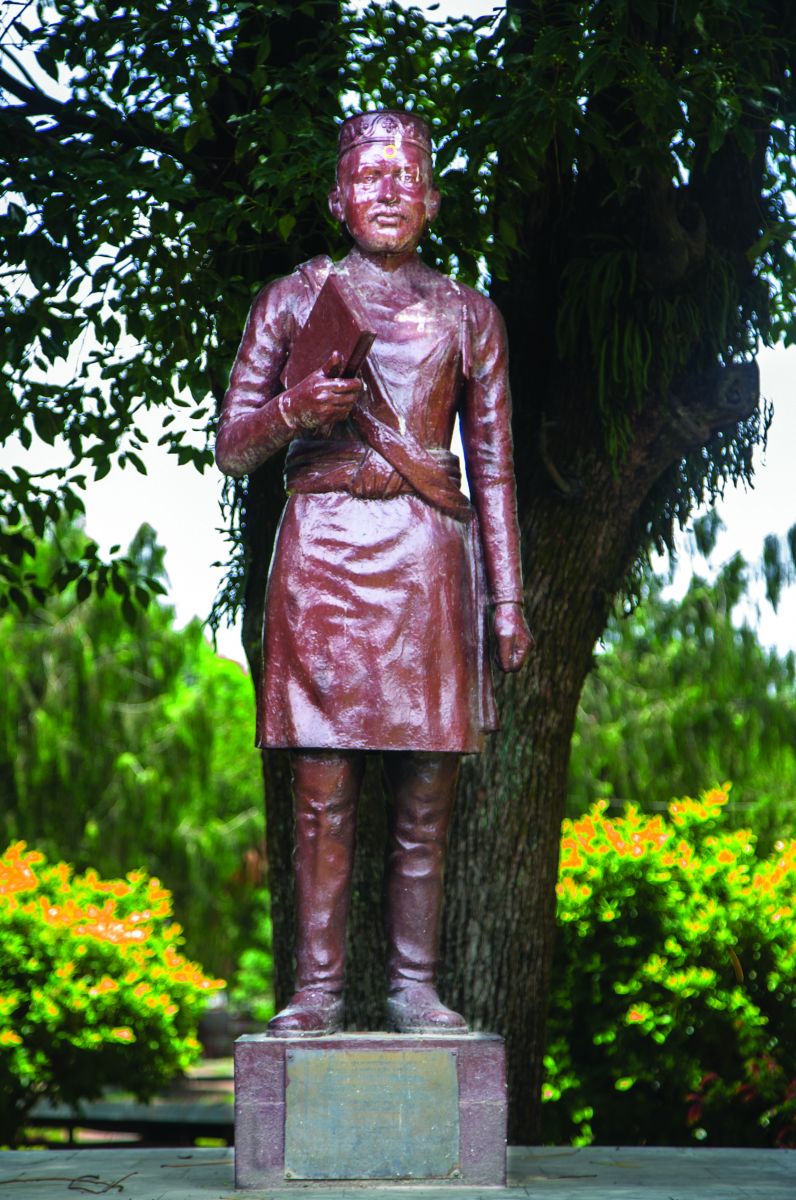
The bust of a mustachioed gentleman wearing the traditional labeda with a sash over the right shoulder and a black rounded topi, holding a book in his right hand, is a familiar image seen at crossroads, parks and mostly at schools. This image is of Adikavi Bhanubhakta Acharya, the first poet in the Nepali language, the language that we speak today. Previously, literary works of prose and poetry were written mostly in Sanskrit, a language limited to the Brahmin class. He thus contributed to develop the Nepali language and literature, which at that time was constrained to the oral medium. The title of Adikavi or ‘the first poet’ was given to Bhanhubhakta by Moti Ram Bhatt in the 1890s while writing his biography. Moti Ram Bhatta was another very famous poet after the times of Bhanubhakta, and the person who actually published the works of Bhanubhakta, posthumously, popularizing his life and writing. The title of Adikavi was later officially approved by Prime Minister Juddha Shumsher. In late 1960s Bhanubhakta was declared a National Icon, or Rashtiya Bibhuti, by the Nepali Government and a stamp was published with his iconic pose in 1962. Information about him was included in school text books from then on and students read his poems and prose. A second stamp was issued for his bi-centenary birth celebration in 2013. In 2015, a silver coin of NRs 2,000/- denomination was put out to commemorate him and his contribution to Nepali culture.
As we celebrate Bhanu Jayanti this year, it is good to know a little more about the history of the celebration. The first statue of the Adikavi was installed in Darjeeling, in 1949 by the Nepali Sahitya Sammelan. However in Nepal, the talks regarding this were initiated only in 1953 by Nepal Siksha Parishad. The completion of the statue was much delayed and was finally inaugurated by King Mahendra on the day of Bhanu Jayanti in 1959, overlooking Ranipokhari, on the boundary wall of Durbar High School. Soon the practice spread too many parts of Nepal, to the premises of Prithvinarayan Campus in Pokhara, his birthplace- Rangha, Dhading Besi, Birjung, Janakpur, Dharan, Biratnagar, Bhadrapur and many more. In Kathmandu itself, there is a bust in L.R.I. Higher Secondary School in Kalanki, and two full-body statues, one in the premises of the Bhanubhakta Memorial Higher Secondary School, and the other in the compound of the Royal Nepal Academy, were installed.
However the culture of celebrating the birth anniversary or Bhanu Jayanti, which falls on 29th Asad (this year 14 July, 2019), was initiated in Darjeeling as an annual event from 1949. This was taken up in Dharan in 1946 and soon spread to Birjung. In his birth town, a library, Bhanu Pustakalaya, was established, with a statue on the premises in 1951. And in Kathmandu, the first celebrations started from 1952 and have continued and now become a nation-wide affair. Nowadays the occasion is celebrated with literary events, poetry recitals, debates, drama performances and competitions.
The 163rd Bhanu Jayanti was celebrated with the inauguration of a Bhanu Memorial building and museum at Rangha by the Bhanu Sewa Samiti. The building was inaugurated by the then State Minister of Education Harka Bahadur Gurung over a three day celebration, with poetry recitals and speeches by politicians, poets and family members. Such celebration on the occasion of Bhanu Jayanti have continued to take place here. The samiti wishes to publish literary articles, and maintain the museum, library as well as the guest house and encourage scholarships on the literary and cultural activities related to the life of the poet, however has not received enough attention from the state.
Born into a privileged Brahmin family in 1814, at Chundi Ramgha gaun in Tanahu district of western Nepal, Bhanu Bhakta was home-educated by his grandfather. He once met a grass-cutter who was saving his hard-earned money to build a well for the community. The spirit to serve of this poor man inspired and motivated the young man to do something for others. His major contribution to society was the translation of the epic Ramayan from Sanskrit to Nepali, making it accessible and comprehensible to lay people. His other famous works are the verses he wrote to the Prime Minister from prison requesting his freedom and expressing the poor conditions of the prison. Although his prison sentence was a misunderstanding, his health deteriorated there and he finally succumbed to the effects of this in 1868, at therelatively young age of 54. He never got to see any of his works published during his lifetime.
This year celebrates the 206th birth anniversary of the poet. He is often said to be the second unifier of the nation after King Prithivi Narayan Shah. The former made a linguistic unification, whereas the latter is better known for his political unification. As we celebrate Bhanu Jayanti this year on 14 July, 2019, we should also be motivated to serve our society and make contributions for it betterment.
The author is a scholar in Nepalese culture, with special interest in art & iconography. She can be reached at swostirjb@gmail.com











